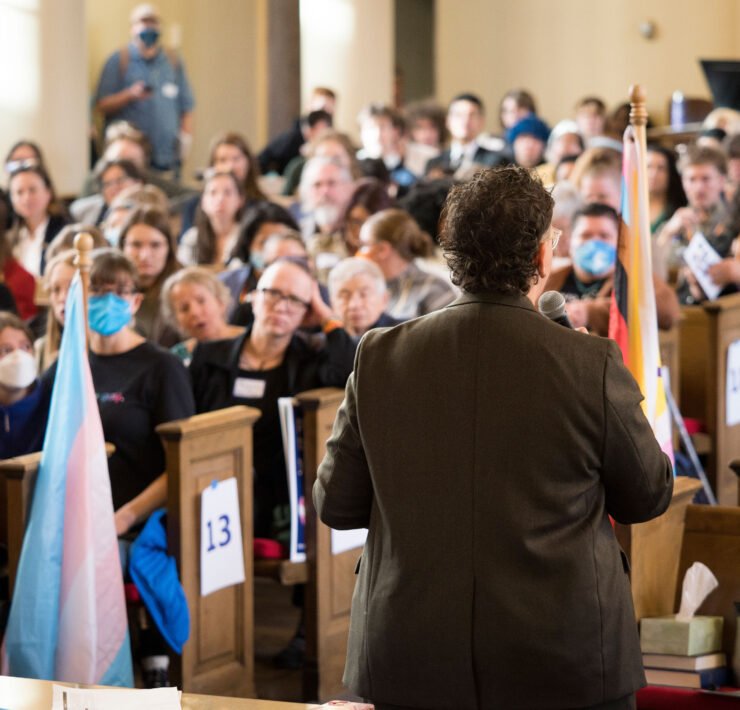OFM Profiles: Queer, Black, and Leading

When the word “leadership” is mentioned, everyone conjures up an image. Perhaps you think of a politician, strongly guiding their constituents in what they think is the right direction. Perhaps you think of a CEO, making those top-level decisions that everyone will have to live with. It’s not often that someone will think of the academic, the entrepreneur, or the nonprofit director. Even more rarely will that person be imagined as identifying as queer and Black. Meet three people who are changing that.
Dr. D-L Stewart (he/him, they/them), is not only an academic in CSU’s College of Education; he is also a member of the administrative team that leads YouthSeen, an organization dedicated to supporting QTBIPOC and LGBTQ youth. His work over the last two decades has focused mainly on intersectionality and academia, with a specific focus on the college and university experience, which he states, has “deliberately set itself against the life chances of minoritized (by race, gender, sexuality, disability, etc.) students.” Dr. Stewart believes, though, that the best way to make a difference is not only to research the systems that we live within, but to also show up and “do the work,” a lot of which means being engaged and involving oneself in the community. Coincidentally, this has been the most difficult part of being Dr. Stewart. As someone who lives outside of Denver (which has a larger queer community), Dr. Stewart finds it hard to engage and connect, but he hopes his move to University of Denver will help to alleviate that.
On the topic of involving oneself in the community, Meet Keo, the founder of New Thinkers and experienced Entrepreneur. Keo has worked with several top, national brands such as United Airlines and 1800 Tequila. Keo’s mission is to solve world problems right here from our own city, and she has translated that into New Thinkers, which is an organization dedicated to doing just that. In 2020, she invited the Central Park 5 to an event that resonated throughout the state. Regarding the organization, she says, “My surprise is finding out that it’s not just a select group of people that are New Thinkers; perhaps we all are.”
That line hits home when you speak with Nadine Bridges, executive director of ONE Colorado, an organization dedicated to advancing equality for all LGBTQ people in the state. She has had quite the journey to becoming the powerhouse she is today. Much of that journey began, though, because she was surrounded by youth throughout the years, which includes her time at Rainbow Alley. Seeing them come into themselves and take over the leadership roles without diminishing parts of themselves resonated with Nadine and inspired her on her own journey to self-acceptance.
These three inspiring individuals have had such different experiences, and yet one major thing ties them all together: mental health and wellness. On the topic, Keo says, “How many times have we heard ‘don’t cry?’” It is critically important to speak out when we are in crisis mode, and it benefits everyone when we can go to someone who is able to listen intentionally when we aren’t. Still, though, Keo mentions it’s important to have those “partners in light,” people who you don’t have to say everything to but are there to support you during the times you may be struggling.
On the subject, Dr. Stewart says we know it is of critical importance, and the important thing now to is to make sure good mental health “isn’t happenstance.” It’s all about having people who are willing to understand the system and then “disrupt and uproot” that same system. Understanding that the instances of mental health challenges are not due to the internalization of identity issues, but rather society’s reaction to identity is key, Dr. Stewart says. We need to “reframe the conversation.”
Keo echoed those sentiments, stating, “We can decide to not enter into conversations” with those implicit biases surrounding identity. This message is right in line with Keo’s New Thinkers as she hopes to bring in young people with new ideas to solve the world’s issues. The truth of this becomes apparent with Nadine, who made a point to mention that the youth are her inspiration.
For these three individuals though, leadership looks different. Nadine states that you “… have to create the space for it to be OK to not be OK,” and a lot of that starts with policy, like allowing the use of mental health days.
Dr. Stewart, for his part, believes that the biggest part of leadership is showing up and engaging with the community. “Ninety-five percent of leadership is showing up,” he says. For Keo, leadership is bringing others along on a journey you’ve already been through. For her, having to be a bulldozer to be heard in spaces that she’s been in, is an experience that she believes people shouldn’t have to be in.
What these leaders have in common, though, is that, despite some of their differences and approaches, they are all showing up and making a difference for a community that needs them, and in the long run, this will not only help the queer, Black community, but it will help the queer, Black community thrive in Denver.
*Photos courtesy of story subjects










